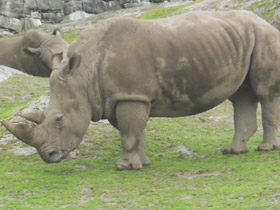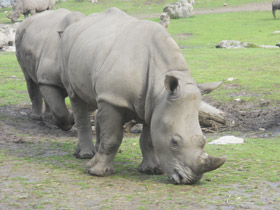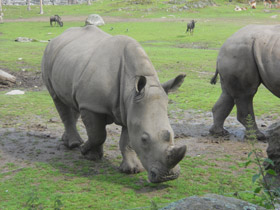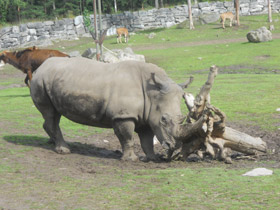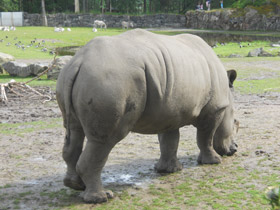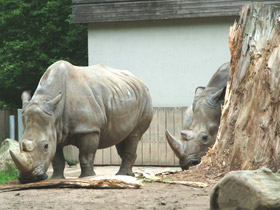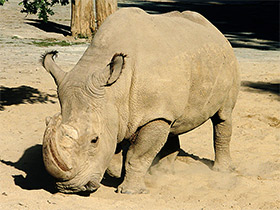The white rhinoceros, white rhino or square-lipped rhinoceros (Ceratotherium simum)
The white rhinoceros, white rhino or square-lipped rhinoceros (Ceratotherium simum) is the largest extant species of rhinoceros. It has a wide mouth used for grazing and is the most social of all rhino species. The white rhinoceros consists of two subspecies: the southern white rhinoceros, with an estimated 16,803 wild-living animals, and the much rarer northern white rhinoceros. The northern subspecies has very few remaining individuals, with only two confirmed left in 2018 (two females: Fatu, 18 and Najin, 29), both in captivity. Sudan, the world's last known male Northern white rhinoceros, died in Kenya on 19 March 2018 at age 45.
Naming
A popular albeit widely discredited theory of the origins of the name "white rhinoceros" is a mistranslation from Dutch to English. The English word "white" is said to have been derived by mistranslation of the Dutch word "wijd", which means "wide" in English. The word "wide" refers to the width of the rhinoceros' mouth. So early English-speaking settlers in South Africa misinterpreted the "wijd" for "white" and the rhino with the wide mouth ended up being called the white rhino and the other one, with the narrow pointed mouth, was called the black rhinoceros. Ironically, Dutch (and Afrikaans) later used a calque of the English word, and now also call it a white rhino. This suggests the origin of the word was before codification by Dutch writers. A review of Dutch and Afrikaans literature about the rhinoceros has failed to produce any evidence that the word wijd was ever used to describe the rhino outside of oral use.
An alternative name for the white rhinoceros, more accurate but rarely used, is the square-lipped rhinoceros. The white rhinoceros' generic name, Ceratotherium, given by the zoologist John Edward Gray in 1868, is derived from the Greek terms keras (κέρας) "horn" and thērion (θηρίον) "beast". Simum, is derived from the Greek term simos (σιμός), meaning "flat nosed".
Distribution
The southern white rhino lives in Southern Africa. About 98.5% of white rhinos live in just five countries (South Africa, Namibia, Zimbabwe, Kenya, and Uganda). Almost at the edge of extinction in the early 20th century, the southern subspecies have made a tremendous comeback. In 2001 it was estimated that there were 11,670 white rhinos in the wild with a further 777 in captivity worldwide, making it the most common rhino in the world. By the end of 2007 wild-living southern white rhinos had increased to an estimated 17,480 animals (IUCN 2008).
The northern white rhino (Ceratotherium simum cottoni) formerly ranged over parts of northwestern Uganda, southern Chad, southwestern Sudan, the eastern part of Central African Republic, and northeastern Democratic Republic of the Congo (DRC). The last surviving population of wild northern white rhinos are or were in Garamba National Park, Democratic Republic of the Congo (DRC) but in August 2005, ground and aerial surveys conducted under the direction of African Parks Foundation and the African Rhino Specialist Group (ARSG) only found four animals: a solitary adult male and a group of one adult male and two adult females. In June 2008 it was reported that the species may have gone extinct in the wild.
Like the black rhino, the white rhino is under threat from habitat loss and poaching, most recently by Janjaweed. Although there are no measurable health benefits, the horn is sought after for traditional medicine and jewelry.
Description
The white rhinoceros is the largest of the five living species of rhinoceros. By mean body mass, the white rhinoceros falls behind only the three extant species of elephant as the largest land animal and terrestrial mammal alive today. It weighs slightly more on average than a hippopotamus despite a considerable mass overlap between these two species. It has a massive body and large head, a short neck and broad chest.
The head and body length is 3.7–4 m (12.1–13.1 ft) in males and 3.35–3.65 m (11.0–12.0 ft) in females, with the tail adding another 70 cm (28 in), and the shoulder height is 170–186 cm (5.58–6.10 ft) in the male and 160–177 cm (5.25–5.81 ft) in the female. The male, averaging about 2,000–2,300 kg (4,410–5,070 lb) is heavier than the female, at an average of about 1,600–1,700 kg (3,530–3,750 lb). The largest size the species can attain is not definitively known; specimens of up to 3,600 kg (7,940 lb) are considered reliable, while larger sizes up to 4,500 kg (9,920 lb) have been claimed but are not verified. On its snout it has two horn-like growths, one behind the other. These are made of solid keratin, in which they differ from the horns of bovids (cattle and their relatives), which are keratin with a bony core, and deer antlers, which are solid bone.
The front horn is larger and averages 60 cm (24 in) in length, reaching as much as 166 cm (65 in) but only in females. The white rhinoceros also has a noticeable hump on the back of its neck. Each of the four stumpy feet has three toes. The color of the body ranges from yellowish-brown to slate grey. Its only hair is the ear fringes and tail bristles. White rhinos have a distinctive broad, straight mouth which is used for grazing. Its ears can move independently to pick up sounds, but it depends most of all on its sense of smell. The olfactory passages that are responsible for smell are larger than their entire brain. The white rhinoceros has the widest set of nostrils of any land-based animal.
Behavior and ecology
White rhinos are found in grassland and savannah habitat. Herbivore grazers that eat grass, preferring the shortest grains, the white rhinoceros is one of the largest pure grazers. It drinks twice a day if water is available, but if conditions are dry it can live four or five days without water. It spends about half of the day eating, one-third resting, and the rest of the day doing various other things. White rhinos, like all species of rhinoceros, love wallowing in mud holes to cool down. The white rhinoceros is thought to have changed the structure and ecology of the savanna's grasslands. Comparatively, based on studies of the African elephant, scientists believe the white rhino is a driving factor in its ecosystem. The destruction of the megaherbivore could have serious cascading effects on the ecosystem and harm other animals.
White rhinos produce sounds which include a panting contact call, grunts and snorts during courtship, squeals of distress, and deep bellows or growls when threatened. Threat displays (in males mostly) include wiping its horn on the ground and a head-low posture with ears back, combined with snarl threats and shrieking if attacked. The vocalizations of the two species differ between each other, and the panting contact calls between individual white rhinos in each species can vary as well. The differences in these calls aid the white rhinos in identifying each other and communicating over long distances. The white rhinoceros is quick and agile and can run 50 km/h (31 mph).
White rhinos live in crashes or herds of up to 14 animals (usually mostly female). Sub-adult bulls will congregate, often in association with an adult cow. Most adult bulls are solitary. Dominant bulls mark their territory with excrement and urine. The dung is laid in well defined piles. It may have 20 to 30 of these piles to alert passing white rhinos that it is his territory. Another way of marking their territory is wiping their horns on bushes or the ground and scraping with their feet before urine spraying. They do this around ten times an hour while patrolling territory. The same ritual as urine marking except without spraying is also commonly used. The territorial male will scrape-mark every 30 m (100 ft) or so around its territory boundary. Subordinate males do not mark territory. The most serious fights break out over mating rights with a female. Female territory overlaps extensively, and they do not defend it.
Taxonomy and evolution
The white rhinoceros of today was said to be likely descended from Ceratotherium praecox which lived around 7 million years ago. Remains of this white rhino have been found at Langebaanweg near Cape Town. A review of fossil rhinos in Africa by Denis Geraads has however suggested that the species from Langebaanweg is of the genus Ceratotherium, but not Ceratotherium praecox as the type specimen of Ceratotherium praecox should, in fact, be Diceros praecox, as it shows closer affinities with the black rhinoceros Diceros bicornis. It has been suggested that the modern white rhino has a longer skull than Ceratotherium praecox to facilitate consumption of shorter grasses which resulted from the long-term trend to drier conditions in Africa. However, if Ceratotherium praecox is in fact Diceros praecox, then the shorter skull could indicate a browsing species. Teeth of fossils assigned to Ceratotherium found at Makapansgat in South Africa were analysed for carbon isotopes and the researchers concluded that these animals consumed more than 30% browse in their diet, suggesting that these are not the fossils of the extant Ceratotherium simum which only eats grass. It is suggested that the real lineage of the white rhino should be; Ceratotherium neumayri → Ceratotherium mauritanicum → C. simum with the Langebaanweg rhinos being Ceratotherium sp. (as yet unnamed), with black rhinos being descended from C. neumayri via Diceros praecox.
Recently, an alternative scenario has been proposed under which the earliest African Ceratotherium is considered to be Ceratotherium efficax (now synonymous with C. mauritanicum), known from the Late Pliocene of Ethiopia and the Early Pleistocene of Tanzania. This species is proposed to have been diversified into the Middle Pleistocene species C. mauritanicum in northern Africa, C. germanoafricanum in East Africa, and the extant C. simum. The first two of these are extinct, however, C. germanoafricanum is very similar to C. simum and has often been considered a fossil and ancestral subspecies to the latter. The study also doubts the ancestry of C. neumayri from the Miocene of southern Europe to the African species. The ancestor of both the black and the white rhinos was likely a mixed feeder, with the two lineages then specializing in browsing and grazing, respectively. The oldest definitive record of the White Rhinoceros is during the mid-Early Pleistocene at Olduvai Gorge in Tanzania, around 1.8 Ma.
Southern white rhinoceros (Ceratotherium simum simum)
As of 2021, there were an estimated 15,940 southern white rhinos in the wild, making them by far the most abundant subspecies of rhino in the world. The number of southern white rhinos outnumbers all other rhino subspecies combined. South Africa is the stronghold for this subspecies with 12,968 individuals recorded in 2021. There are smaller reintroduced populations within the historical range of the species in Namibia, Botswana, Zimbabwe, Uganda and Eswatini, while a small population survives in Mozambique. Populations have also been introduced outside of the former range of the species to Kenya and Zambia.
Northern white rhinoceros (Ceratotherium simum cottoni)
The northern white rhinoceros or northern square-lipped rhinoceros (Ceratotherium simum cottoni) is considered critically endangered and possibly extinct in the wild. Formerly found in several countries in East and Central Africa south of the Sahara, this subspecies is a grazer in grasslands and savanna woodlands.
Initially, six northern white rhinoceros lived in the Dvůr Králové Zoo in the Czech Republic. Four of the six rhinos (which were also the only reproductive animals of this subspecies) were transported to Ol Pejeta Conservancy in Kenya, where scientists hoped they would successfully breed and save this subspecies from extinction. One of the two remaining in the Czech Republic died in late May 2011. Both of the last two males capable of natural mating died in 2014 (one in Kenya on 18 October and one in San Diego on 15 December). In 2015, the Kenyan government placed the last remaining male of the subspecies at Ol Pejeta under 24-hour armed guard to deter poachers, but he was put down on 19 March 2018 due to multiple health problems caused by old age, leaving just two females alive which reside at the Ol Pejeta complex. Staff hope to inseminate the remaining females with the last male's semen, although the semen is not preferable due to the age of the rhino.
Following the phylogenetic species concept, recent research has led to the hypothesis that the northern white rhinoceros is a different species, rather than a subspecies of white rhinoceros as was previously thought, in which case the correct scientific name for the former should be Ceratotherium cottoni. Distinct morphological and genetic differences suggest the two proposed species have been separated for at least a million years. However, the results of the research were not universally accepted by other scientists.
Reproduction
Females reach sexual maturity at 6–7 years of age while males reach sexual maturity between 10 and 12 years of age. Courtship is often a difficult affair. The bull stays beyond the point where the cow acts aggressively and will give out a call when approaching her. The bull chases and or blocks the way of the cow while squealing or wailing loudly if the cow tries to leave his territory. When ready to mate the cow curls her tail and gets into a stiff stance during the half-hour copulation. Breeding pairs stay together between 5–20 days before they part their separate ways. The gestation period of a white rhino is 16 months. A single calf is born and usually weighs 40–65 kg (88–143 lb). Calves are unsteady for their first two to three days of life. When threatened, the baby will run in front of the mother, which is very protective of her calf and will fight for it vigorously. Weaning starts at two months, but the calf may continue suckling for over 12 months. The birth interval for the white rhino is between two and three years. Before giving birth, the mother will chase off her current calf. White rhinos can live to be up to 40–50 years old.
White rhino female and young grazing in the Pilanesberg National Park
Adult white rhinos have no natural predators (other than humans) due to their size, and even young rhinos are rarely attacked or preyed on due to the mother's presence and their tough skin. One exceptional successful attack was perpetrated by a lion pride on a sick bull white rhinoceros, which weighed 1,540 kg (3,400 lb), and occurred in Mala Mala Game Reserve, South Africa.
Modern conservation tactics
The northern white rhino is critically endangered to the point that only two of these rhinos are known to remain in the world, both in captivity. Several conservation tactics have been taken to prevent this subspecies from disappearing from the planet. Perhaps the most notable type of conservation effort for these rhinos is having moved them from Dvur Kralove Zoo in the Czech Republic to Kenya's Ol Pejeta Conservancy on 20 December 2009, where they have been under constant watch every day, and have been given favorable climate and diet, to which they have adapted well, to boost their chances of reproducing.
In captivity
Most white rhinos in zoos are southern white rhinos; in 2021 it was estimated that there were over 1000 southern white rhinos in captivity worldwide. Wild-caught southern whites will readily breed in captivity given appropriate amounts of space and food, as well as the presence of other female rhinos of breeding age. However, for reasons that are not currently understood, the rate of reproduction is extremely low among captive-born southern white females.
The San Diego Zoo Safari Park in San Diego, California, US had two northern white rhinos, one of which was wild-caught. On 22 November 2015, a 41-year-old female named Nola (born in 1974), which had been on loan from the Dvůr Králové Zoo in Dvůr Králové, Czech Republic) since 1989, was euthanized after experiencing a downturn in health. On 14 December 2014, a 44-year-old male named Angalifu died of old age at the San Diego Zoo. The other four captive northern white rhinos were loaned to Ol Pejeta Conservancy in Kenya, and only two remain alive. Females Najin and Fatu are still living, while males Suni and Sudan died in 2014 and 2018, respectively. The northern white rhinos had been transferred to Ol Pejeta Conservancy from the Dvůr Králové Zoo in 2009 in an attempt to protect the taxa in their natural habitat. The only two northern white rhinos left are maintained under 24-hour armed guard in Kenya.









